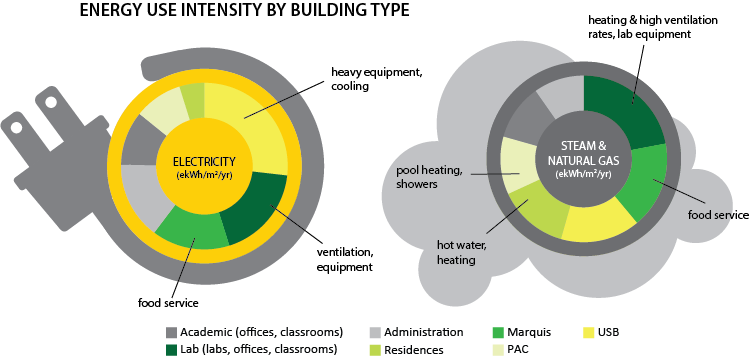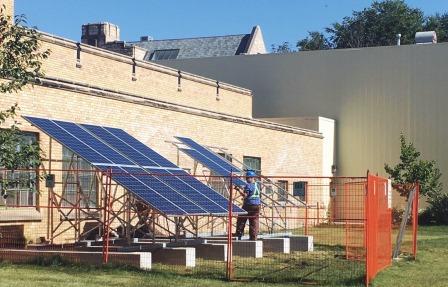Energy Consumption
It takes a lot of energy to run a university and the U of S is committed to managing energy consumption efficiently, wisely and responsibly. On October 9, 2014, the university's Board of Governors approved the Energy and Water Conservation Policy.
In 2012/13 we consumed 29,750,000 m3 of natural gas and 132,000,000 kWh of electricity. That's roughly the natural gas and electricity used by 12,000 Canadian homes1.
Energy is used on campus for:
- Heating, cooling and ventilating buildings
- Heating water
- Lighting
- Powering computers, other equipment in buildings, parking lot receptacles
- Fleet vehicles
- Food service
The Central Heating & Cooling plant burns natural gas to generate steam which is used for heating, research processes, heating swimming pools and domestic hot water. In summer, the plant uses electricity to chill water to provide air conditioning across campus.
Learn what you can do at school, work or home to conserve energy.
1 Based on data from Statistics Canada, Households and the Environment: Energy Use, 2011.
Energy Use By Building Type
The University of Saskatchewan is home to a wide variety of buildings that run the gamut of sizes and uses. Energy use intensity (EUI, measured in terms of building energy use/unit area of building floor space/year) allows for comparison of the energy consumed in buildings of different sizes. This helps us account for how certain types of buildings use more energy than others (for example, an office building or elementary school uses relatively little energy compared to a hospital). In Canada, food service buildings, grocery stores and hospitals have the highest EUIs. Similarly, on campus certain activities lead to higher rates of energy use. The figure below shows the EUIs of campus building types relative to each other.
Lab buildings typically require much more ventilation, which consumes more heat (from steam) and electricity (to run large fan motors). Equipment other than the office equipment and lighting found in all academic and administrative buildings, accounts for some of the additional electrical use in lab buildings. Providing food for tens of thousands of people on campus uses a lot of energy.

Initiatives
The Energy Action Plan has helped to provide funding for a massive lighting retrofit across campus, replacing older, inefficient bulbs with newer LED equivalents. As of March, 2017, the following buildings have been completed under this initiative:
- University Services Building
- Animal Science Building
- Education Building
- Thorvaldson Building
- Administration Building
- Engineering Building
- Law Building
- Edwards School of Business
- Physics Building
- Murray Building
- Toxicology Building
- Arts Building
- VIDO/Intervac
- McLean Hall
- Kirk Hall
- Williams Building
- John Mitchell Building
- Dental Clinic
- Diefenbaker Canada Centre
- Education and PAC Pools
- Museum of Antiquities
Lighting retrofits have been taking place on campus for many years now, with last calculated savings in 2015 being estimated at 17,893 Gj/yr of electricity or more than $250,000. These retrofits largely involve the replacement of magnetic ballast incandescent or compact fluorescent fixtures with more energy efficient electronic ballasts and LED bulbs. In addition to conserving energy, these measures improve lighting quality. The energy saved by the retrofits (as of 2015 estimates) reduces our greenhouse gas emissions by an estimated 4,240,000 kg CO2/yr, an amount roughly equivalent to taking 656 cars and light trucks off the road in Saskatchewan.
The University is currently investigating options for transitioning its outdoor lighting systems to LED equivalents.

The installation of a 24-kilowatt solar panel system at the Horticulture Science Field Facility (located south of the main campus on 14th Street) was one step to fulfilling the university's commitment to reducing its greenhouse gas emissions. The array will supply about 70% of the horticulture facility's electricity each year, about the same as it takes to power 3.7 homes for a year.